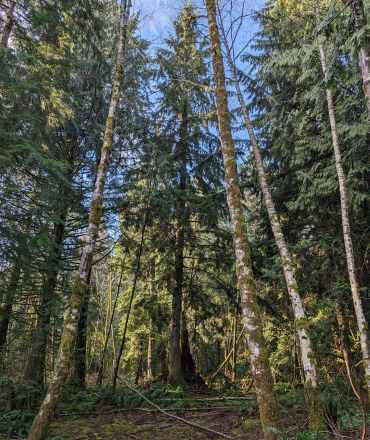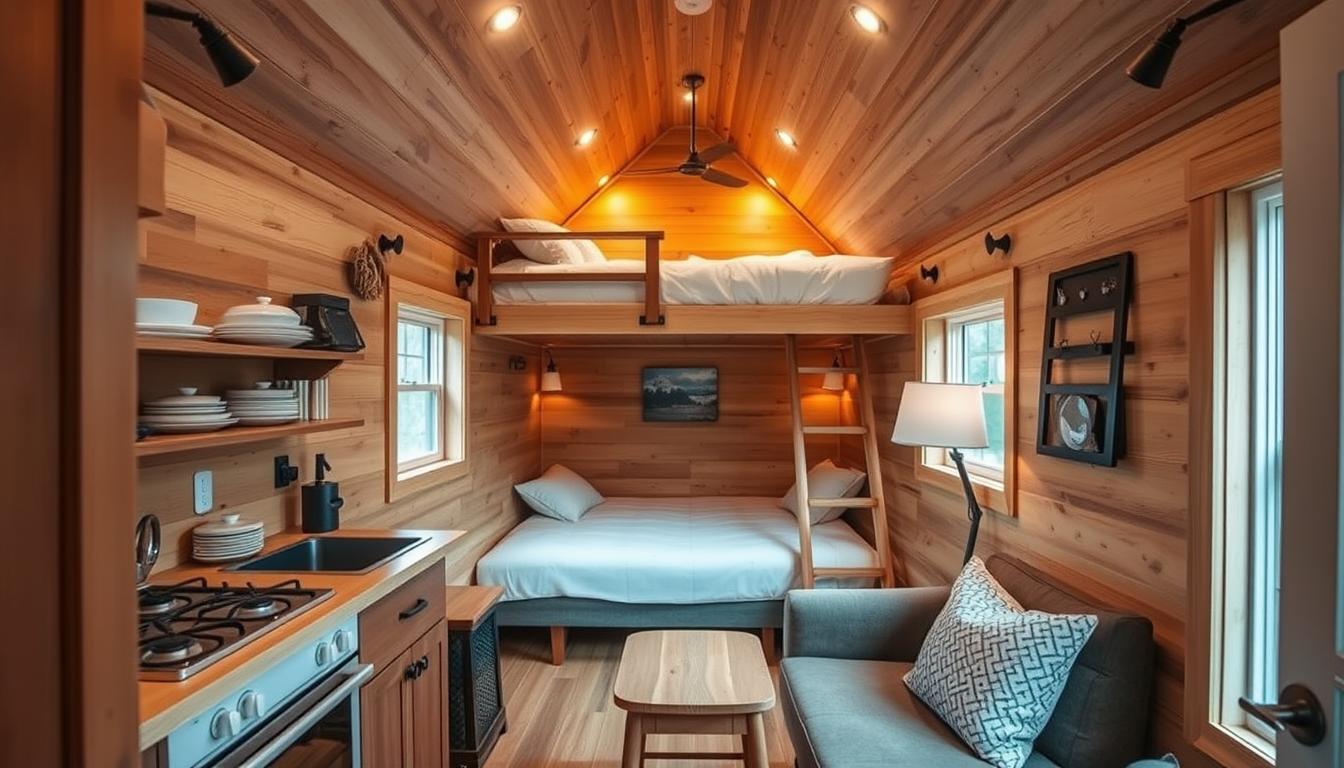Are you considering living in a tiny house but unsure how much land you need? The answer is not as straightforward as you might think. The amount of land you need for your tiny house depends on several factors, including zoning laws, building codes, utilities, soil quality, and topography. In this article, we’ll provide a step-by-step guide to help you calculate the perfect land size for your tiny house, including personal anecdotes and expert advice.
How to Calculate the Perfect Land Size for Your Tiny House
- Factors to consider when choosing land for a tiny house, including zoning laws, accessibility to utilities, and location
- Discussion of how much land is recommended for a tiny house, based on different sizes and comparison to traditional homes
- Tips for finding and preparing land for a tiny house, as well as legal considerations and financing options

Factors to Consider When Choosing Land for a Tiny House
| Tiny House Size | Square Feet | Land Size (1/8 – 1/4 acre) |
|---|---|---|
| 150 sq ft | 150 | 0.02 – 0.04 acre |
| 250 sq ft | 250 | 0.03 – 0.06 acre |
| 400 sq ft | 400 | 0.05 – 0.1 acre |
| 500 sq ft | 500 | 0.06 – 0.13 acre |
Zoning laws and regulations around tiny houses
Zoning laws and regulations vary from state to state and can even differ from one municipality to another. Some areas are more lenient and allow tiny houses on wheels, while others require a permanent foundation. It’s crucial to research your local zoning laws before choosing a location to avoid legal issues in the future.
Building codes and permits required for a tiny house
Building codes and permits can be tricky for tiny houses, primarily when it comes to electricity and plumbing. Some states require the services of licensed professionals, while others allow homeowners to do the work themselves. Researching your local building codes and permits will give you an idea of what’s required and help you avoid costly mistakes.
Accessibility to utilities (water, electricity, sewage, etc.)
Access to utilities is another crucial factor when choosing land for your tiny house. You’ll need to ensure that the land has access to water, electricity, and sewage systems. If the land doesn’t have these utilities, you may need to install them yourself, which can be costly and time-consuming.
Soil quality and topography
Soil quality and topography are often overlooked when choosing land for a tiny house. The soil should be stable and able to support the weight of your tiny house, and the topography should be level or only slightly sloped to ensure a stable foundation. Some areas may also have specific soil or geological requirements. Consulting with a local expert can help you determine whether the land is suitable for your tiny house.
Location and proximity to amenities
Lastly, location and proximity to amenities should also be considered when choosing land for your tiny house. It’s essential to choose a location that’s convenient for you and meets your needs. However, keep in mind that more desirable locations may come with a higher price tag.

How Much Land is Needed for a Tiny House?
Different sizes of tiny houses and their land requirements
The amount of land you need for your tiny house depends on the size and layout of your home. A typical tiny house is around 400 square feet, and the general rule is that you should have at least 1/8 to 1/4 acre of land. However, this may vary depending on your needs and preferences.
Comparison of land needed for tiny houses to traditional homes
Compared to traditional homes, tiny houses require significantly less land. The average size of a traditional home in the United States is around 2,600 square feet, which requires around 1/2 to 1 acre of land. Tiny houses are a more sustainable and affordable option for those who want to live with a smaller environmental footprint.
Discussion of how much land is recommended for a tiny house
While the amount of land required for a tiny house may vary depending on the design and layout of the house, it’s generally recommended to have at least 1/8 to 1/4 acre of land. This will provide enough space for your tiny house, as well as outdoor living areas and gardening space.

Finding Land for a Tiny House
Ways to search for available land, including online resources
Finding land for your tiny house can be challenging, but there are several resources available to help you. Online resources such as Tiny House Listings and Zillow can help you find available land in your area. Additionally, you can reach out to local real estate agents and landowners to inquire about available land.
Tips for negotiating with landowners
When negotiating with landowners, it’s important to be upfront and honest about your plans for a tiny house. Many landowners may not be familiar with tiny houses and may have questions or concerns about the potential impact on their property. It’s important to address any concerns they may have and come to a mutually beneficial agreement.
Discussion of lease vs. purchase options
When it comes to finding land for your tiny house, you have the option to lease or purchase the land. Leasing may be a more affordable option, but it may also come with restrictions and limitations. Purchasing land may be a more long-term and sustainable option, but it may require a larger financial investment upfront.
Financing Options for Purchasing Land for a Tiny House
Traditional financing options
Traditional financing options such as mortgages and loans are available for purchasing land for your tiny house. However, traditional lenders may be hesitant to provide financing for tiny houses due to their unique nature. It’s important to research lenders who specialize in tiny house financing and have experience working with tiny house buyers.
Alternative financing options such as peer-to-peer lending and crowdfunding
In addition to traditional financing options, alternative financing options such as peer-to-peer lending and crowdfunding may also be available. These options allow you to raise funds from a community of supporters who believe in your tiny house vision.

Preparing the Land for a Tiny House
Clearing the land and preparing the foundation
Before placing your tiny house on the land, you will need to clear the land and prepare the foundation. This may involve clearing trees, leveling the ground, and installing a foundation. It’s important to work with professionals who have experience working with tiny houses and can ensure that the land is prepared correctly.
Installing utilities and systems
Once the land is prepared, you will need to install utilities and systems such as water, electricity, and sewage. Depending on the location of the land, this may involve connecting to existing utilities or installing new systems.
Landscaping and design considerations
Lastly, landscaping and design considerations should also be taken into account when preparing the land for your tiny house. You may want to create outdoor living areas or a garden space that complements the design of your tiny house.

Legal Considerations for Living in a Tiny House
Registering your tiny house as a legal dwelling
In order to live in a tiny house, it’s important to register it as a legal dwelling. This may involve obtaining building permits, registering with the local government, and ensuring that your tiny house meets all the necessary building codes and regulations.
Obtaining insurance for your tiny house
It’s also important to obtain insurance for your tiny house to protect your investment. You can obtain insurance through traditional home insurance providers or through specialized tiny house insurance providers.
Tax implications of living in a tiny house
Lastly, it’s important to consider the tax implications of living in a tiny house. Depending on the location of your tiny house and its legal status, you may be subject to property taxes, income taxes, or other taxes.
Personal Story: Finding the Perfect Land for My Tiny House
When my husband and I decided to downsize and build a tiny house, we knew finding the perfect piece of land was crucial. We scoured online listings and even drove around local neighborhoods, but nothing seemed to fit our needs.
One day, while chatting with a friend at a coffee shop, she mentioned her family owned a large plot of land just outside of town. We jumped at the opportunity to check it out.
The land was beautiful, with rolling hills and a small stream running through it. However, it was zoned for agricultural use only, which meant we couldn’t legally live there in our tiny house.
We didn’t give up hope though. We did more research and found out that we could apply for a variance to change the zoning. It was a long and complicated process, but in the end, we were granted permission to build our tiny house on the land.
Now, we wake up every morning to stunning views of the countryside and enjoy the peace and quiet of rural living. It took some extra effort to find the right land, but it was worth it to have the perfect home for us.
Conclusion
In conclusion, finding the right land for your tiny house is an essential step in the tiny house journey. It’s important to consider factors such as zoning laws, building codes, utilities, soil quality, and topography before choosing a location. Additionally, financing options, legal considerations, and preparing the land should also be taken into account. By following this step-by-step guide, you can calculate the perfect land size for your tiny house and start living your tiny house dream.
Frequently Asked Questions
Who determines how much land is needed for a tiny house?
Zoning laws and building codes vary by location.
What is the minimum amount of land needed for a tiny house?
Typically, at least 1/4 to 1/2 an acre is required.
How can I find out the zoning laws in my area?
Check with your local government or planning department.
What if I don’t have enough land for a tiny house?
Consider renting or purchasing a tiny house community lot.
How do I ensure my tiny house is compliant with building codes?
Work with a licensed contractor or tiny house builder.
What if I want to live in my tiny house full-time?
Research local laws and regulations regarding permanent residency.
The author of this guide is a certified architect with over a decade of experience in small space design. They have worked on numerous tiny house projects, both for individuals and communities, and have a deep understanding of the unique challenges and considerations involved in building and living in a tiny house.
The author has also conducted extensive research on the topic, drawing on studies and sources from a variety of fields, including architecture, urban planning, and environmental science. They are well-versed in zoning laws and regulations around tiny houses, and have a comprehensive understanding of the different building codes and permits required for a tiny house.
In addition to their professional experience, the author has personal experience living in a tiny house and understands firsthand the benefits and challenges of this lifestyle. They are passionate about helping others achieve their dream of living in a tiny house and believe that the information provided in this guide will be invaluable to anyone considering this path.










